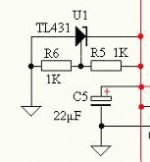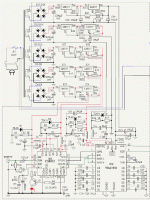This circuit is from a power supply to CS-8412 +5V rail. The DC is 7V from a 317 regulated source. Since this is already regulated by 317 to 7V, we can config 317 to produce 5V. Why does it need to add another regulation stage by TL431? If TL431 is better than 317, then we should feed the DC after rectification and cap to TL431 to produce +5V, then why is it necessary to go through 317?
Attachments
Sunsun22 said:Yes TL431 is a shunt regulator but is a regulated voltage (from 317 in this circuit) a pre-requisite to perform shunt regulation?
The 431 acting as a shunt should be fed with a current, I suspect the 317 is configured as a current source. Show us the full schematic and it will become clear.
best
sivan_and said:TL431 is a band gap referenced shunt requlator..If fed from a constant current source the accuracy will increase..
Why ?
cheers
Sunsun22 said:I have difficulties to reduce the entire circuit. But with a little help from my friend, here is the complete circuit.
Indeed, the 317's are configured as current sources. Unfortunately the designers short the current sources with lytics - too bad.
best,
-
Guido
So, are these 431s any good then?
I always thought they were essentially a programmable zener, and I was trained to believe that a zener diode was a crude, noisy form of regulation.
However, a lot of people seem to like them (they feature in the Kwak clock's regulation for instance (admittedly with a driving transistor).
I would of thought a 431 would be better as a first form of regulation, followed by a low noise regulator - but I have no real experience of them (except they worked in my Kwak clock, but no idea how well).
Cheers,
Phil
I always thought they were essentially a programmable zener, and I was trained to believe that a zener diode was a crude, noisy form of regulation.
However, a lot of people seem to like them (they feature in the Kwak clock's regulation for instance (admittedly with a driving transistor).
I would of thought a 431 would be better as a first form of regulation, followed by a low noise regulator - but I have no real experience of them (except they worked in my Kwak clock, but no idea how well).
Cheers,
Phil
philpoole said:So, are these 431s any good then?
I always thought they were essentially a programmable zener, and I was trained to believe that a zener diode was a crude, noisy form of regulation.
However, a lot of people seem to like them (they feature in the Kwak clock's regulation for instance (admittedly with a driving transistor).
I would of thought a 431 would be better as a first form of regulation, followed by a low noise regulator - but I have no real experience of them (except they worked in my Kwak clock, but no idea how well).
Cheers,
Phil
They are nice but not quiet, the equivalent noise at the ref input is 100nV/SqrrtHz and the LF noise increases rapidly.
LEDs are quiet but more temperature dependant. That usually doesn't matter that much as most components are quite tolerant in terms of absolute supply voltage.
best
Guido
philpoole said:So, if the 431 is noisy, in this case, why not just use the LM317s as the regulation stages?
Not trying to be argumentative, just trying to understand the 431s usage more.
The 431 is a precision voltage reference, far more accurate and stable that a regulator.
philpoole said:So, if the 431 is noisy, in this case, why not just use the LM317s as the regulation stages?
Not trying to be argumentative, just trying to understand the 431s usage more.
Cheers,
Phil
the combo of a 431 and 317 as shown in the circuit forms a shunt regulator. This type has some advantages over traditionally used series regs. The point however is that the shunt element defines the noise here.
A 317 isn't that quiet either, look at the noise specs in the datasheets.
An interesting thread about noise has beeninititated by Critter, also on DIYaudio
best
Hi Guido, Nigel,
Thanks for the replies. It makes sense now that it is used for its more stable voltage, rather than its noise.
I agree that the 317 is not particularly low noise (hence I suggested why not just use that instead, as I couldn't, at the time, see an advantage for the 431).
So, a 431 is good for a DAC, as intermediate output values are generated from it (if, that is, the power rails are used as reference voltage on the TDA1541A {I know it doesn't have a seperate Vref input like other DACs}), but a 431 may not be as important for, say a preamp, or a clock module, as we're more interested in having low noise and enough headroom.
Hopefully, I'm starting to understand.
Thanks again.
Phil
Thanks for the replies. It makes sense now that it is used for its more stable voltage, rather than its noise.
I agree that the 317 is not particularly low noise (hence I suggested why not just use that instead, as I couldn't, at the time, see an advantage for the 431).
So, a 431 is good for a DAC, as intermediate output values are generated from it (if, that is, the power rails are used as reference voltage on the TDA1541A {I know it doesn't have a seperate Vref input like other DACs}), but a 431 may not be as important for, say a preamp, or a clock module, as we're more interested in having low noise and enough headroom.
Hopefully, I'm starting to understand.
Thanks again.
Phil
- Status
- This old topic is closed. If you want to reopen this topic, contact a moderator using the "Report Post" button.
- Home
- Source & Line
- Digital Source
- What is the purpose of TL431 in this circuit?

